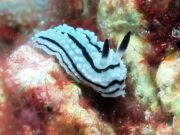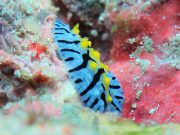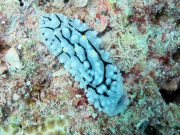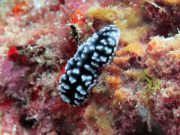Tauchen mit Warzenschnecken
Meeresleben von Lanta | Phyllidiidae
Warzenschnecken sind auf unseren Koh Lanta-Tauchausflügen leicht auszumachen und sofort an ihrem warzigen Mantel und dem Fehlen von Rückenkiemen zu erkennen.
Die meisten Arten sehen ähnlich aus und sind schwarz und weiß, wobei eine mögliche dritte Farbe meist gelb oder orange ist. Einige wenige Arten können auch eine blassgrüne oder blassblaue Färbung aufweisen. Bei einigen Arten können die Warzen durch Grate miteinander verbunden sein.
Der Mantel bedeckt den Fuß, und im Gegensatz zu anderen Nacktschnecken befinden sich die Kiemen an der Unterseite und an der Seite des Körpers.
An der Rückenfläche des Kopfes befinden sich zwei Tentakel, die Rhinophoren genannt werden. Diese Tentakel dienen dazu, Wasserbewegungen und Gerüche im Wasser wahrzunehmen, und können bei Bedarf eingezogen werden. Warzenschnecken haben keine Kiefer oder Zähne, sondern saugen an ihrer Nahrung, hauptsächlich an Schwämmen.
Warzenschnecken sind hermaphroditisch, das heißt, sie haben sowohl männliche als auch weibliche Fortpflanzungsorgane.
5 Arten auf dieser Seite gefunden:
Ocellate Phyllidia
(Phyllidia ocellata)

Phyllidiella ocellata @ Koh Haa
The body colour is highly variable, yellow, orange, brownish or even light grey, with several black and white ocellations (like eye spots on damselfish), which are sometimes connected.
There is considerable individual variation in dorsal patterns in this species, however the most typical dorsal pattern consists of four to ten black rings bordered in white, each with a central gold or white tubercle.
The large tubercles on the dorsum (upper back) are very obvious, and the rhinophores are orange-yellow.
Ceylon Phyllidiidae
(Phyllidiella zeylanica)

Phyllidiella zeylanica @ Koh Haa
The Ceylon Phyllidiidae has numerous ridges of tuberculate which curve to join anteriorly and posteriorly (but may be interrupted).
A single black band (sometimes not complete) encloses both the rhinophores and the anal orifice, and may contain several black markings within the central black ring. The anterior section of this black band is squared, a feature unique to this species.
The foot sole is pale, and the rhinophores are mostly black, with the lower 2 or 3 lamellae being white.
Varicose Wart Slug
(Phyllidia varicosa)

Phyllidia varicosa @ Koh Haa
Capable of changing colours and textures, the Varicose Wart Slug has a generally black under-colour with bluish speckled patches, lines, spots and blotches which contain the yellow and blue warts which can appear to be in rows. Has yellow rhinophores (sensory tentacles behind the head).
The Varicose Wart Slug grows to 7 cm and is a very poisonous species, using its toxins for defence, and has no known predators.
Elegant Sea Slug
(Phyllidia elegans)

Phyllidia elegans @ Koh Haa
The Elegant Sea Slug has a pale coloured foot with a thin black line along the middle. The body warts (tubercles) are light pink, the larger often with yellow tips.
The light pinkish warts may look grey underwater due to loss of red light. The rhinophores (sensory tentacles on the head) often have pale yellow tips.
The Elegant Sea Slug grows to 6.5 cm, feeds solely on sponges and excretes powerful toxins when distressed.
Pimpled Phyllidiella
(Phyllidiella pustulosa)

Phyllidiella pustulosa @ Koh Haa
The Pimpled Phyllidiella has a generally black body colour, with whitish to pinkish to greenish warts (tubercles) and black oral tentacles. The tubercles are usually grouped in clumps. The edge of the mantle is pale pink.
The black body colour forms a net-like pattern, rather than lines which are seen in other similar looking phyllid nudibranchs.
The Pimpled Phyllidiella grows to 6 cm and the body slightly elongate, rather than oval.
This species is highly poisonous.
Tauchen mit Warzenschnecken rund um Koh Lanta
Tauch- und Schnorchelausflüge
Wenn Sie gerne die Gelegenheit hätten, Warzenschnecken auf einem unserer täglichen Tauchausflüge während der Hochsaison von Koh Lanta aus zu sehen, dann senden Sie uns eine E-Mail an info@diveandrelax.com.
Nehmen Sie an unseren Speedboot-Tauchausflügen in der Hochsaison zu einigen der besten Tauchplätze Thailands teil und genießen Sie kleine Gruppen, kurze Fahrzeiten und einen Fokus auf hervorragenden persönlichen Service, Sicherheit und Spaß.
Noch kein zertifizierter Taucher? Lernen Sie auf Koh Lanta das Tauchen mit dem 3-tägigen SSI Open Water Diver Kurs.
Buchen Sie online und sparen Sie 10% auf Tauchausflüge und Tauchkurse auf Koh Lanta.
Weitere Informationen
Indo-Pazifische Meereslebewesen-Führer
- Allen, G., Steene, R., Humann, P., DeLoach, N. (2003) Reef Fish Identification, Tropical Pacific. Jacksonville, FL., USA: New World Publications, Inc., ISBN 1-878348-36-1.
- Humann, P., DeLoach, N., (2010) Reef Creature Identification, Tropical Pacific. Jacksonville, FL., USA: New World Publications Inc., ISBN 978-1-878348-44-9
- Debelius, H. (2013) Indian Ocean Reef Guide. Frankfurt, Germany: IKAN - Unterwasserarchiv, ISBN 978-3-939767-52-7.
- Debelius, H. (2004) Nudibranchs and Sea Snails, Indo-Pacific Field Guide. Frankfurt, Germany: IKAN - Unterwasserarchiv, ISBN 3-925919-51-1
- Erhardt, H., Knop, D. (2015) Corals Indo-Pacific Field Guide. Frankfurt, Germany: IKAN - Unterwasserarchiv, ISBN 3-925919-69-4.
- Veron J.E.N., Stafford-Smith M.G., Turak E. and DeVantier L.M. (2016). Corals of the World
Weitere Referenzen zu Meereslebewesen und weitere Informationen
